Earthquake/Tsunami Damage Assessment for Urban Areas Using Post-Event PolSAR Data
Abstract
:1. Introduction
2. Study Area and Experimental Data
3. Methodology
4. An Improved Classification using Thresholding and Majority Voting
4.1. Preliminary Pixel-Based Classification
4.1.1. Polarization Orientation Angle Compensation
4.1.2. Classification Features
4.1.3. Preliminary Classification Result
4.2. Region-Based Classification Using Thresholding and Majority Voting
4.2.1. Urban and Mountain Area Classification
4.2.2. Majority Voting
5. Damage Information Extraction
5.1. Circular Correlation Coefficient
5.2. Analyses of the Coastal Area of Ishinomaki City
5.3. An Unsupervised Damaged-Building Extraction Algorithm
6. Result and Analysis
6.1. Coastal Area of Ishinomaki City
6.2. Analysis for Two Other Areas
6.3. Comparison with Supervised Damage Assessment Technique
7. Conclusions
Author Contributions
Funding
Acknowledgments
Conflicts of Interest
References
- Brunner, D.; Lemoine, G.; Bruzzone, L. Earthquake Damage Assessment of Buildings Using VHR Optical and SAR Imagery. IEEE Trans. Geosci. Remote Sens. 2010, 48, 2403–2420. [Google Scholar] [CrossRef] [Green Version]
- Matsuoka, M.; Yamazaki, F. Use of satellite SAR intensity imagery for detecting building areas damaged due to earthquakes. Earthq. Spectra 2004, 20, 975–994. [Google Scholar] [CrossRef]
- Matsuoka, M.; Yamazaki, F. Building damage mapping of the 2003 Bam, Iran, earthquake using Envisat/ASAR intensity imagery. Earthq. Spectra 2005, 21, 285–294. [Google Scholar] [CrossRef]
- Matsuoka, M.; Koshimura, S.; Nojima, N. Estimation of building damage ratio due to earthquakes and tsunamis using satellite SAR imagery. In Proceedings of the 2010 IEEE International Geoscience and Remote Sensing Symposium (IGARSS), Honolulu, HI, USA, 25–30 July 2010; pp. 3347–3349. [Google Scholar]
- Lee, J.S.; Pottier, E. Polarimetric Radar Imaging: From Basics to Applications; CRC Press: Boca, FL, USA, 2009. [Google Scholar]
- Yamaguchi, Y. Disaster monitoring by fully polarimetric SAR data acquired with ALOS-PALSAR. Proc. IEEE 2012, 100, 2851–2860. [Google Scholar] [CrossRef]
- Park, S.E.; Yamaguchi, Y.; Kim, D.J. Polarimetric SAR remote sensing of the 2011 Tohoku earthquake using ALOS/PALSAR. Remote Sens. Environ. 2013, 132, 212–220. [Google Scholar] [CrossRef]
- Singh, G.; Yamaguchi, Y.; Boerner, W.M.; Park, S.E. Monitoring of the March 11, 2011, off-Tohoku 9.0 earthquake with super-tsunami disaster by implementing fully polarimetric high-resolution POLSAR techniques. Proc. IEEE 2013, 101, 831–846. [Google Scholar] [CrossRef]
- Chen, S.W.; Sato, M. Tsunami damage investigation of built-up areas using multitemporal spaceborne full polarimetric SAR images. IEEE Trans. Geosci. Remote Sens. 2013, 51, 1985–1997. [Google Scholar] [CrossRef]
- Chen, S.W.; Wang, X.S.; Sato, M. Urban Damage Level Mapping Based on Scattering Mechanism Investigation Using Fully Polarimetric SAR Data for the 3.11 East Japan Earthquake. IEEE Trans. Geosci. Remote Sens. 2016, 54, 6919–6929. [Google Scholar] [CrossRef]
- Zhai, W.; Huang, C. Fast building damage mapping using a single post-earthquake PolSAR image: A case study of the 2010 Yushu earthquake. Earth Planets Space 2016, 68, 86. [Google Scholar] [CrossRef]
- Li, X.; Guo, H.; Zhang, L.; Chen, X.; Liang, L. A new approach to collapsed building extraction using RADARSAT-2 polarimetric SAR imagery. IEEE Geosci. Remote Sens. Lett. 2012, 9, 677–681. [Google Scholar]
- Zhao, L.; Yang, J.; Li, P.; Zhang, L.; Shi, L.; Lang, F. Damage assessment in urban areas using post-earthquake airborne PolSAR imagery. Int. J. Remote Sens. 2013, 34, 8952–8966. [Google Scholar] [CrossRef]
- Zhai, W.; Shen, H.; Huang, C.; Pei, W. Building earthquake damage information extraction from a single post-earthquake PolSAR image. Remote Sens. 2016, 8, 171. [Google Scholar] [CrossRef]
- Ainsworth, T.; Schuler, D.; Lee, J.S. Polarimetric SAR characterization of man-made structures in urban areas using normalized circular-pol correlation coefficients. Remote Sens. Environ. 2008, 112, 2876–2885. [Google Scholar] [CrossRef]
- Shi, L.; Sun, W.; Yang, J.; Li, P.; Lu, L. Building collapse assessment by the use of postearthquake Chinese VHR airborne SAR. IEEE Geosci. Remote Sens. Lett. 2015, 12, 2021–2025. [Google Scholar] [CrossRef]
- Sun, W.; Shi, L.; Yang, J.; Li, P. Building collapse assessment in urban areas using texture information from postevent SAR data. IEEE J. Sel. Top. Appl. Earth Obs. Remote Sens. 2016, 9, 3792–3808. [Google Scholar] [CrossRef]
- Ji, Y.Q.; Sri Sumantyo, J.T.; Chua, M.Y.; Waqar, M.M. Single Post-event PolSAR Data Based Earthquake/Tsunami Damage Information Extraction in Urban Areas. In Proceedings of the Progress in Electromagnetics Research Symposium (PIERS), Toyama, Japan, 1–4 August 2018. to be published. [Google Scholar]
- Japan Aerospace Exploration Agency. Available online: http://global.jaxa.jp/ (accessed on 7 July 2018).
- Shimada, M.; Watanabe, M.; Takahashi, M.; Motooka, T.; Ohki, M.; Yamanokuchi, T.; Miyagi, Y.; Kawano, N.; Shiraishi, T.; Thapa, R. Monitoring the Great East Japan Earthquake Using ALOS. IEEE GRSS Newsl. 2011, 12, 19–24. [Google Scholar]
- Shimada, M.; Tadono, T.; Rosenqvist, A. Advanced Land Observing Satellite (ALOS) and monitoring global environmental change. Proc. IEEE 2010, 98, 780–799. [Google Scholar] [CrossRef]
- Building Damage Map for Tohoku Earthquake/Tsunami. Available online: http://www.tsunami.civil.tohoku.ac.jp/tohoku2011/mapping_damage.html (accessed on 7 July 2018).
- Ji, Y.; Sumantyo Sri, J.T.; Chua, M.Y.; Waqar, M.M. Earthquake/Tsunami Damage Level Mapping of Urban Areas Using Full Polarimetric SAR Data. IEEE J. Sel. Top. Appl. Earth Obs. Remote Sens. 2018. [Google Scholar] [CrossRef]
- Lee, J.S.; Schuler, D.L.; Ainsworth, T.L. Polarimetric SAR data compensation for terrain azimuth slope variation. IEEE Trans. Geosci. Remote Sens. 2000, 38, 2153–2163. [Google Scholar]
- Yamaguchi, Y.; Moriyama, T.; Ishido, M.; Yamada, H. Four-component scattering model for polarimetric SAR image decomposition. IEEE Trans. Geosci. Remote Sens. 2005, 43, 1699–1706. [Google Scholar] [CrossRef]
- Yamaguchi, Y.; Sato, A.; Boerner, W.M.; Sato, R.; Yamada, H. Four-component scattering power decomposition with rotation of coherency matrix. IEEE Trans. Geosci. Remote Sens. 2011, 49, 2251–2258. [Google Scholar] [CrossRef]
- Singh, G.; Yamaguchi, Y.; Park, S.E. General four-component scattering power decomposition with unitary transformation of coherency matrix. IEEE Trans. Geosci. Remote Sens. 2013, 51, 3014–3022. [Google Scholar] [CrossRef]
- Cloude, S.R.; Pottier, E. A review of target decomposition theorems in radar polarimetry. IEEE Trans. Geosci. Remote Sens. 1996, 34, 498–518. [Google Scholar] [CrossRef]
- Xiao, S.P.; Chen, S.W.; Chang, Y.L.; Li, Y.Z.; Sato, M. Polarimetric Coherence Optimization and Its Application for Manmade Target Extraction in PolSAR Data. IEICE Trans. Electron. 2014, 97, 566–574. [Google Scholar] [CrossRef]
- Feng, J.; Cao, Z.; Pi, Y. Polarimetric contextual classification of PolSAR images using sparse representation and superpixels. Remote Sens. 2014, 6, 7158–7181. [Google Scholar] [CrossRef]
- Tarabalka, Y.; Benediktsson, J.A.; Chanussot, J. Spectral–spatial classification of hyperspectral imagery based on partitional clustering techniques. IEEE Trans. Geosci. Remote Sens. 2009, 47, 2973–2987. [Google Scholar] [CrossRef]
- Baatz, M. Multiresolution segmentation: An optimization approach for high quality multi-scale image segmentation. In Angewandte Geographische Informations Verarbeitung XII; Wichmann Verlag: Karlsruhe, Germany, 2000; pp. 12–23. [Google Scholar]
- Kimura, K.; Yamaguchi, Y.; Moriyama, T.; Yamada, H. Circular polarization correlation coefficient for detection of non-natural targets aligned not parallel to SAR flight path in the X-band POLSAR image analysis. IEICE Trans. Electr. 2004, 87, 3050–3056. [Google Scholar]

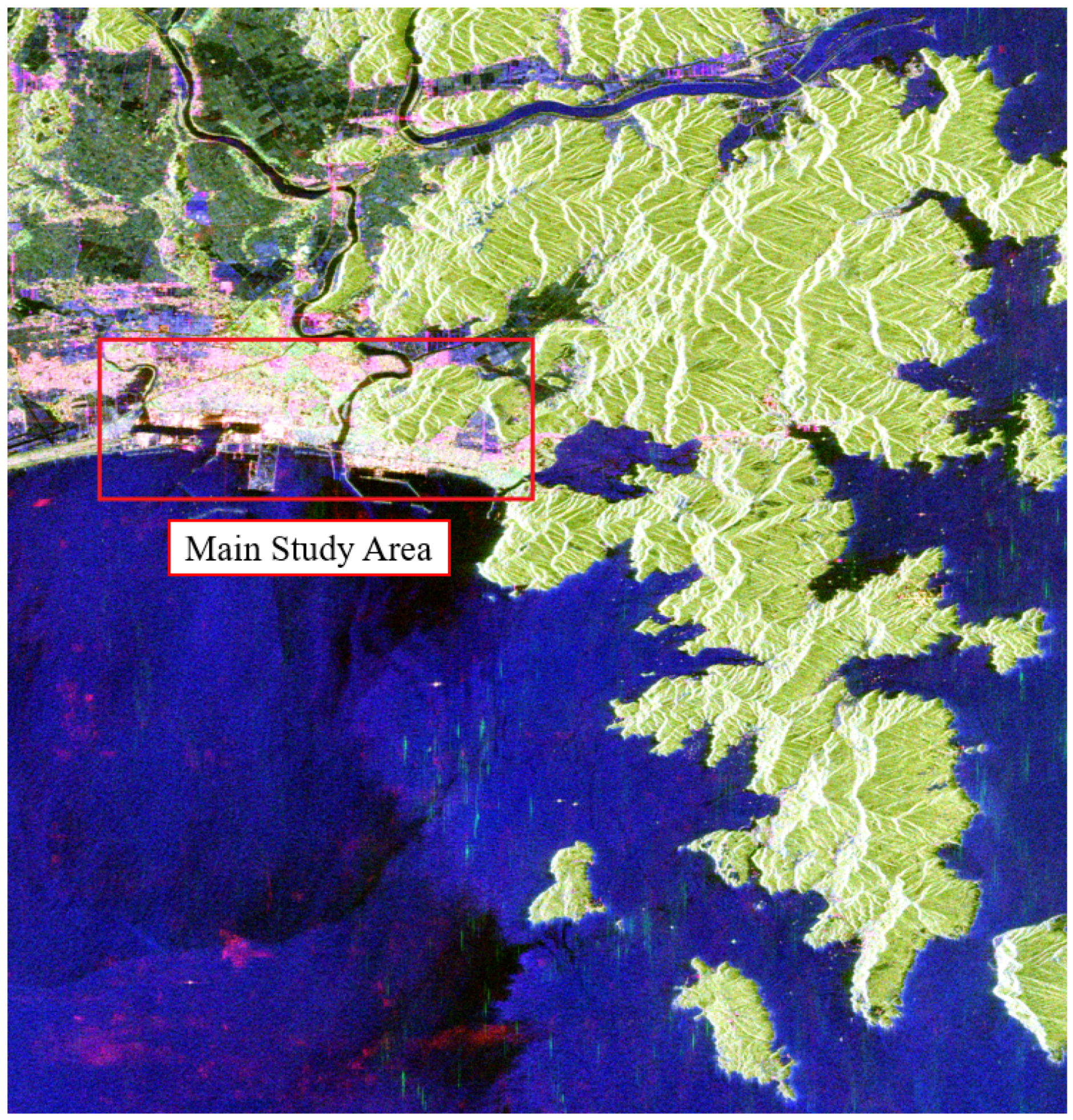



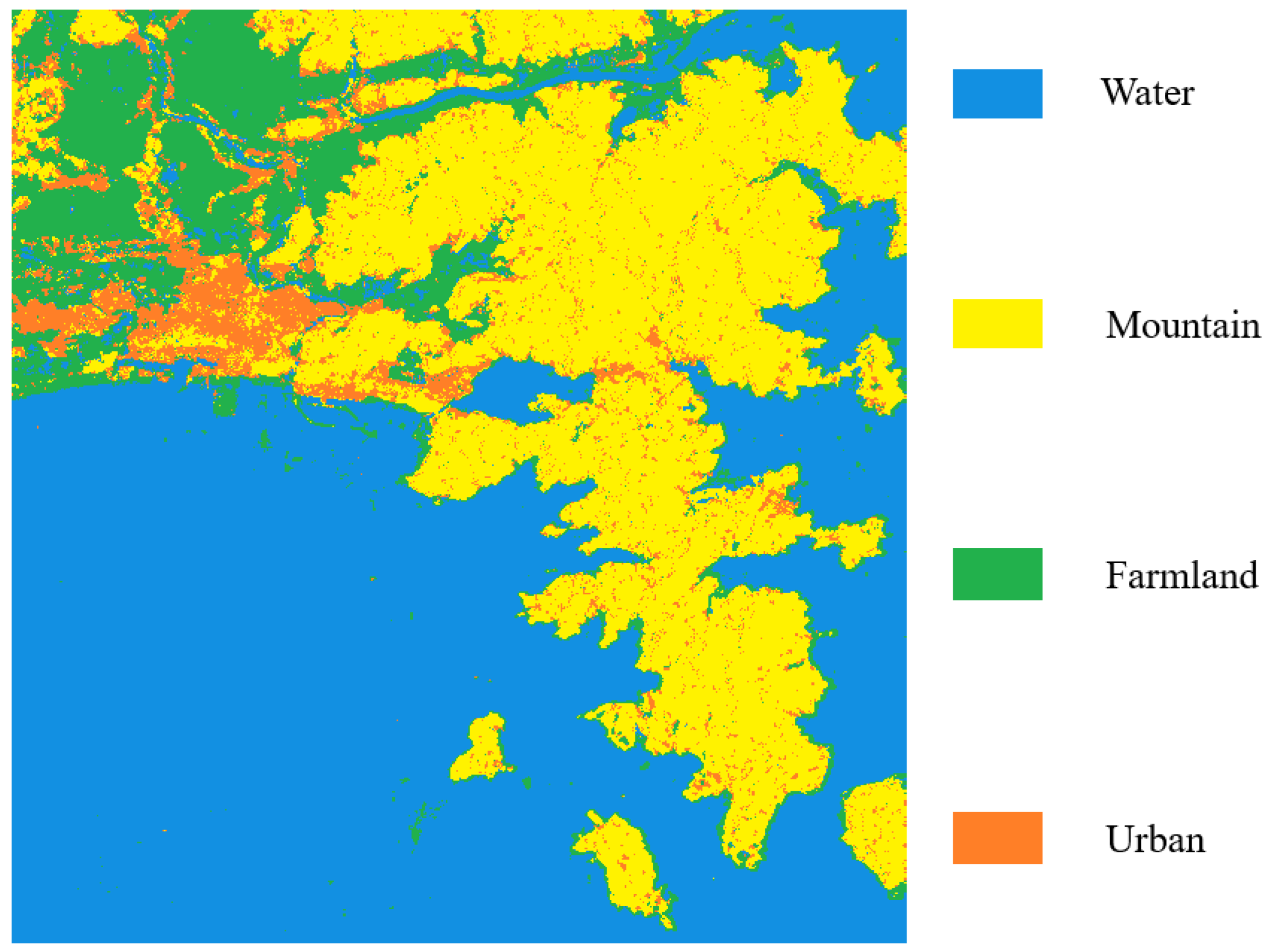
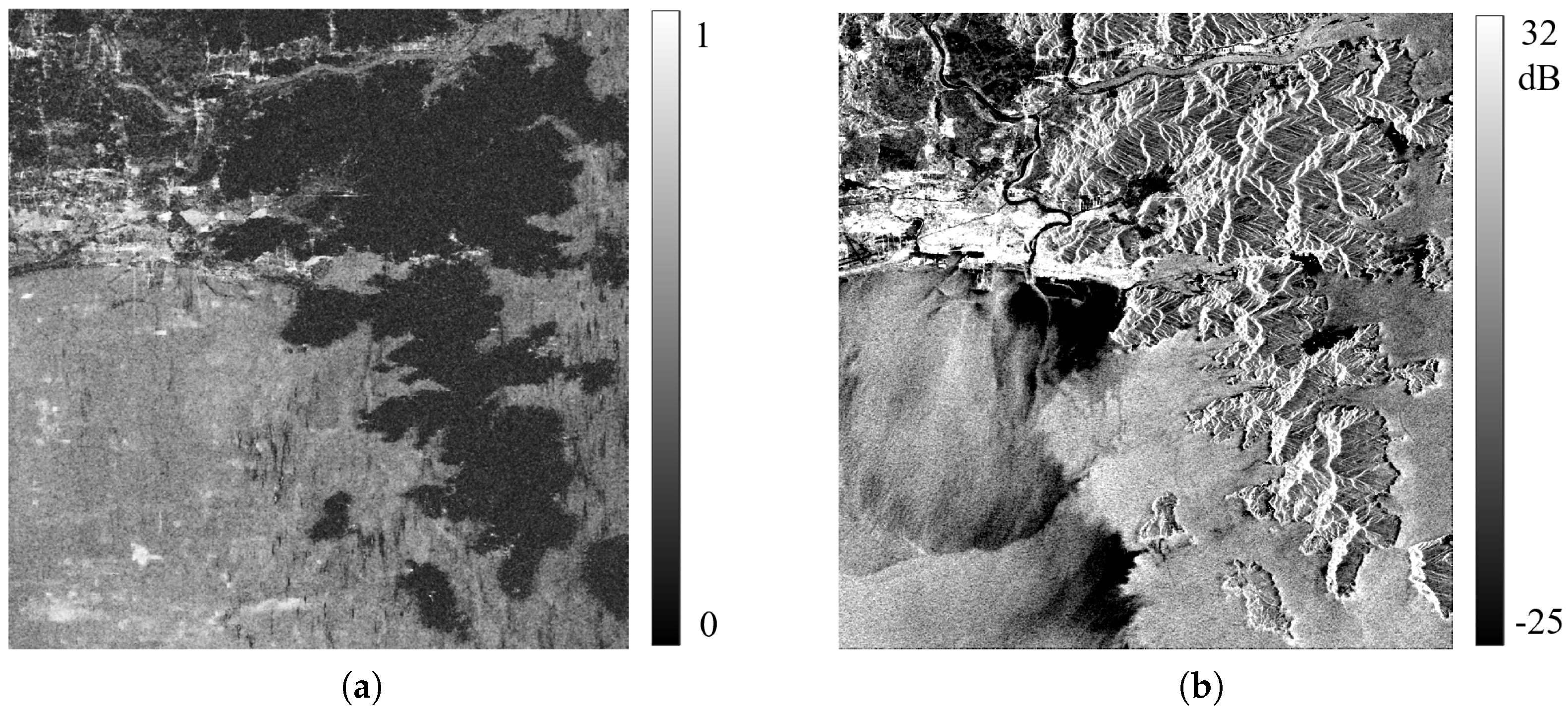
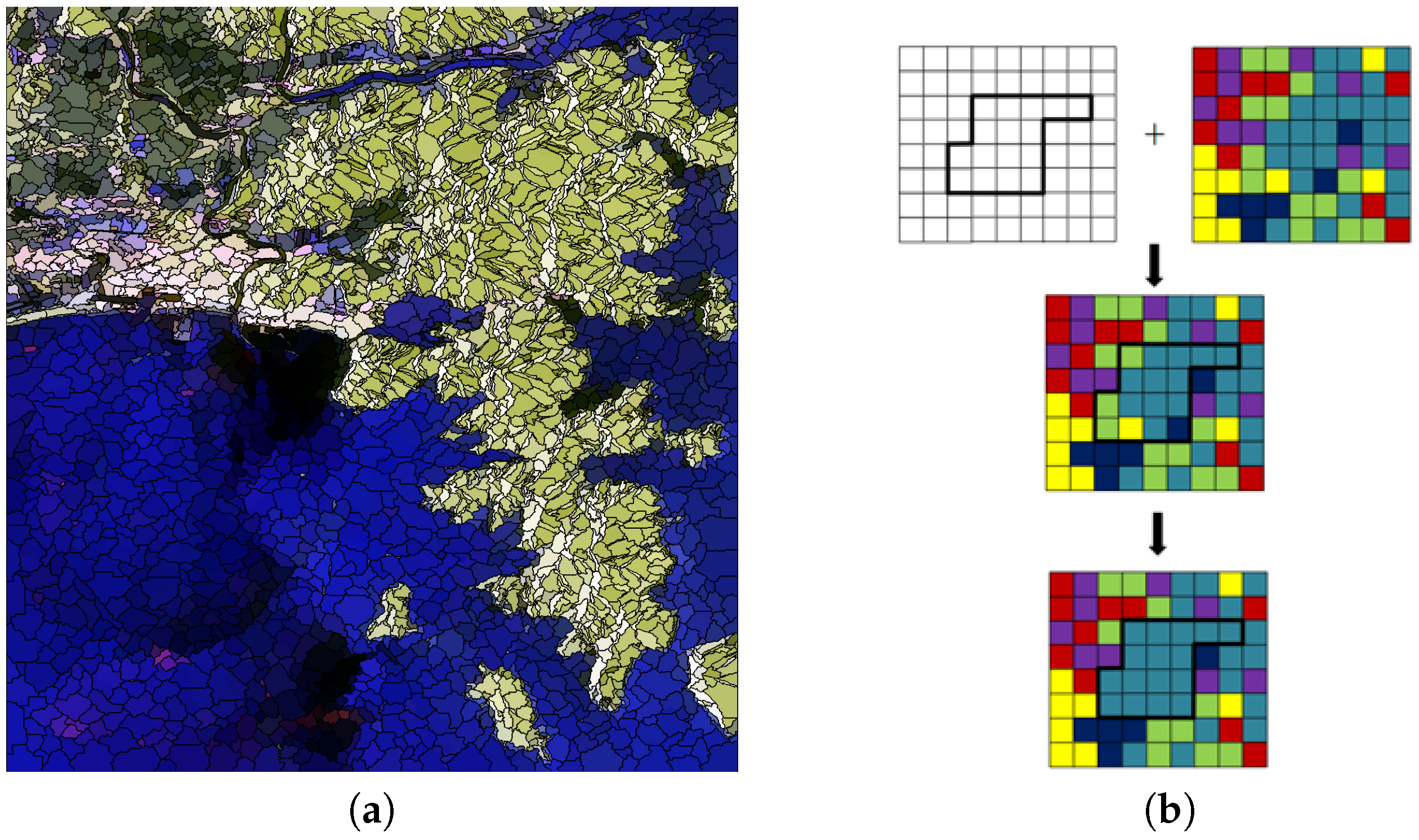
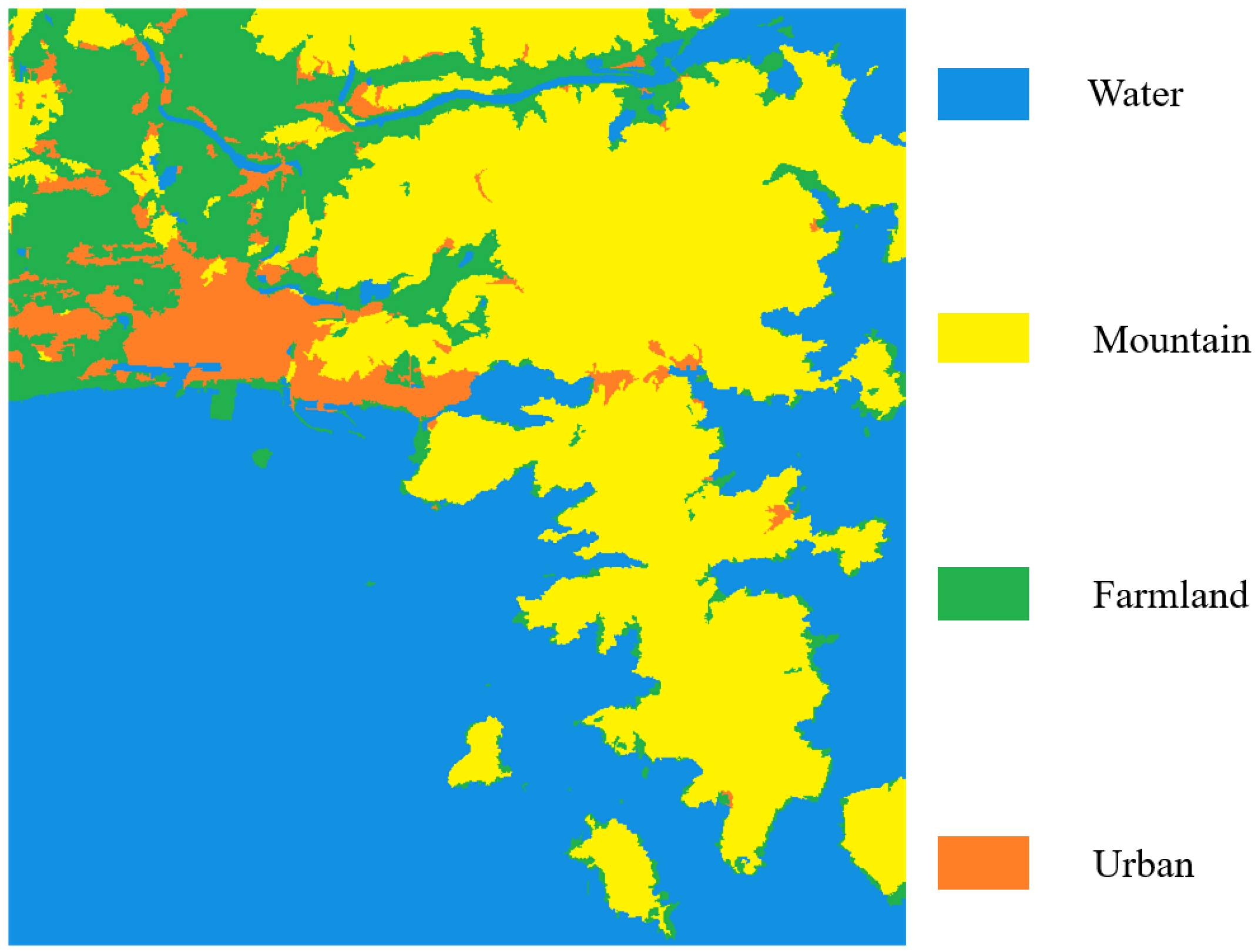
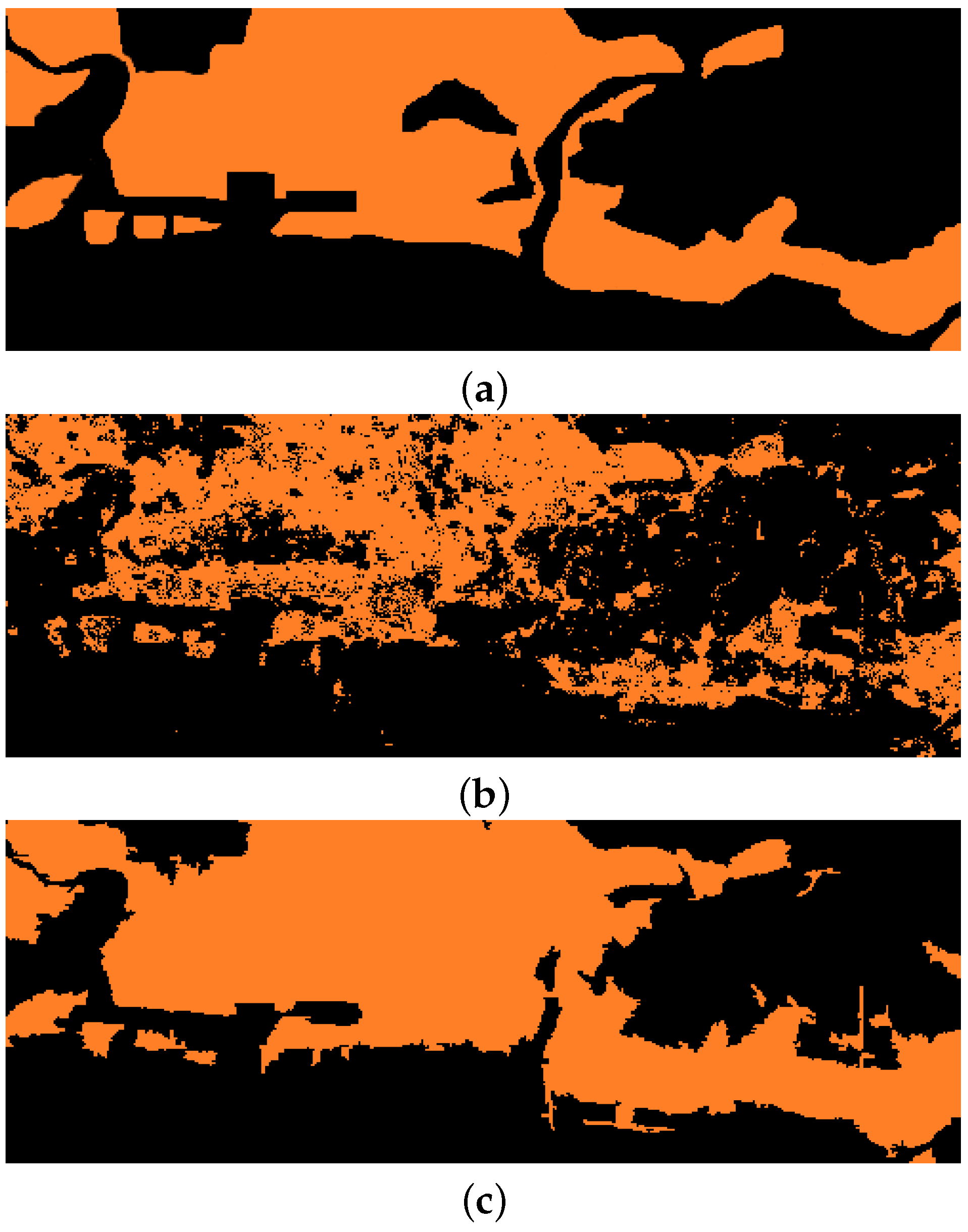
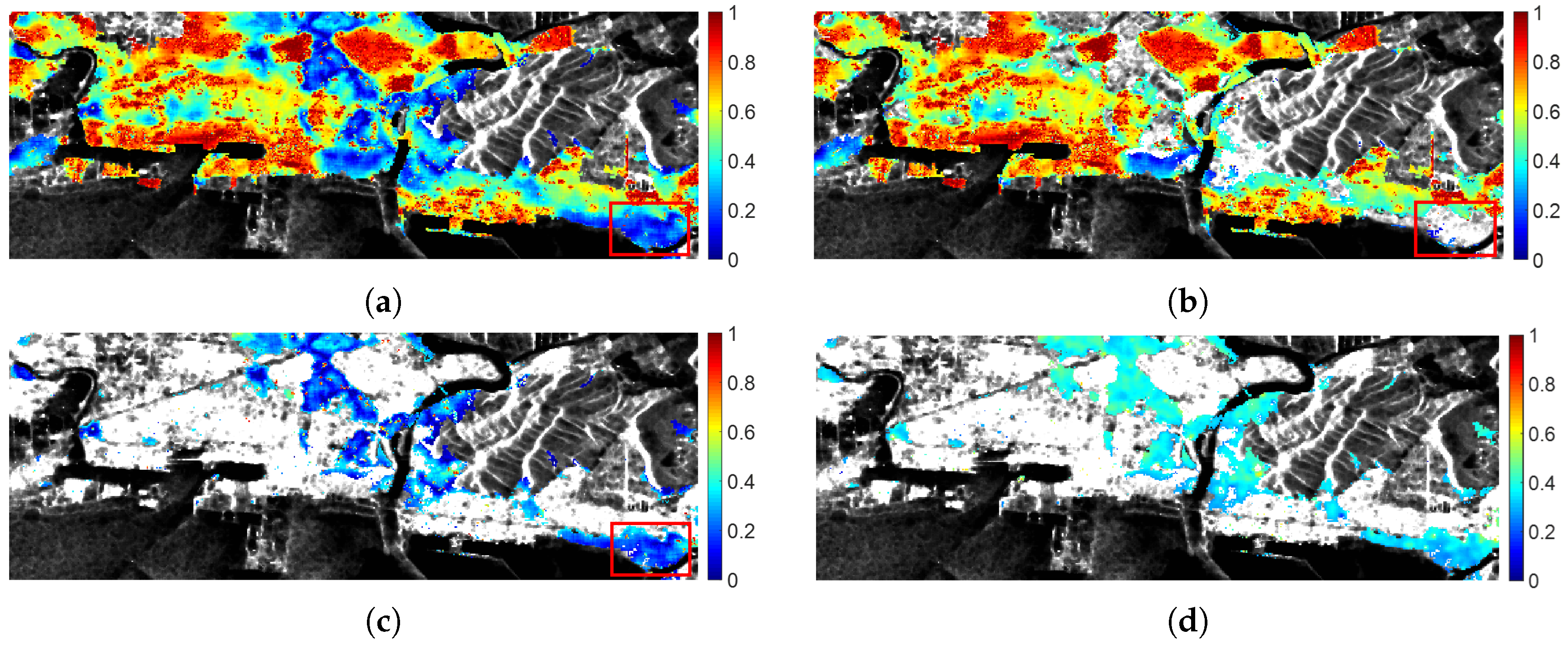
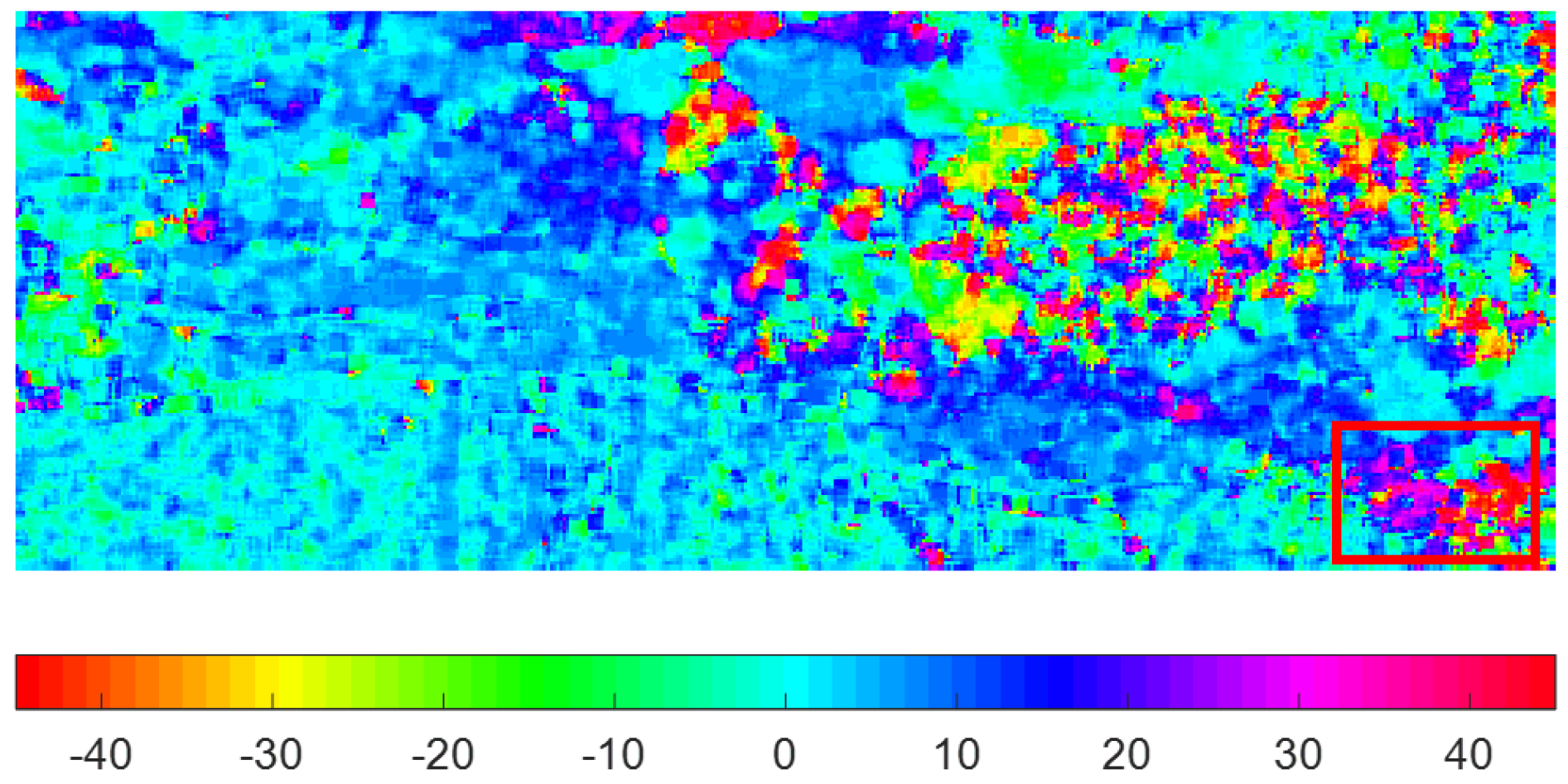


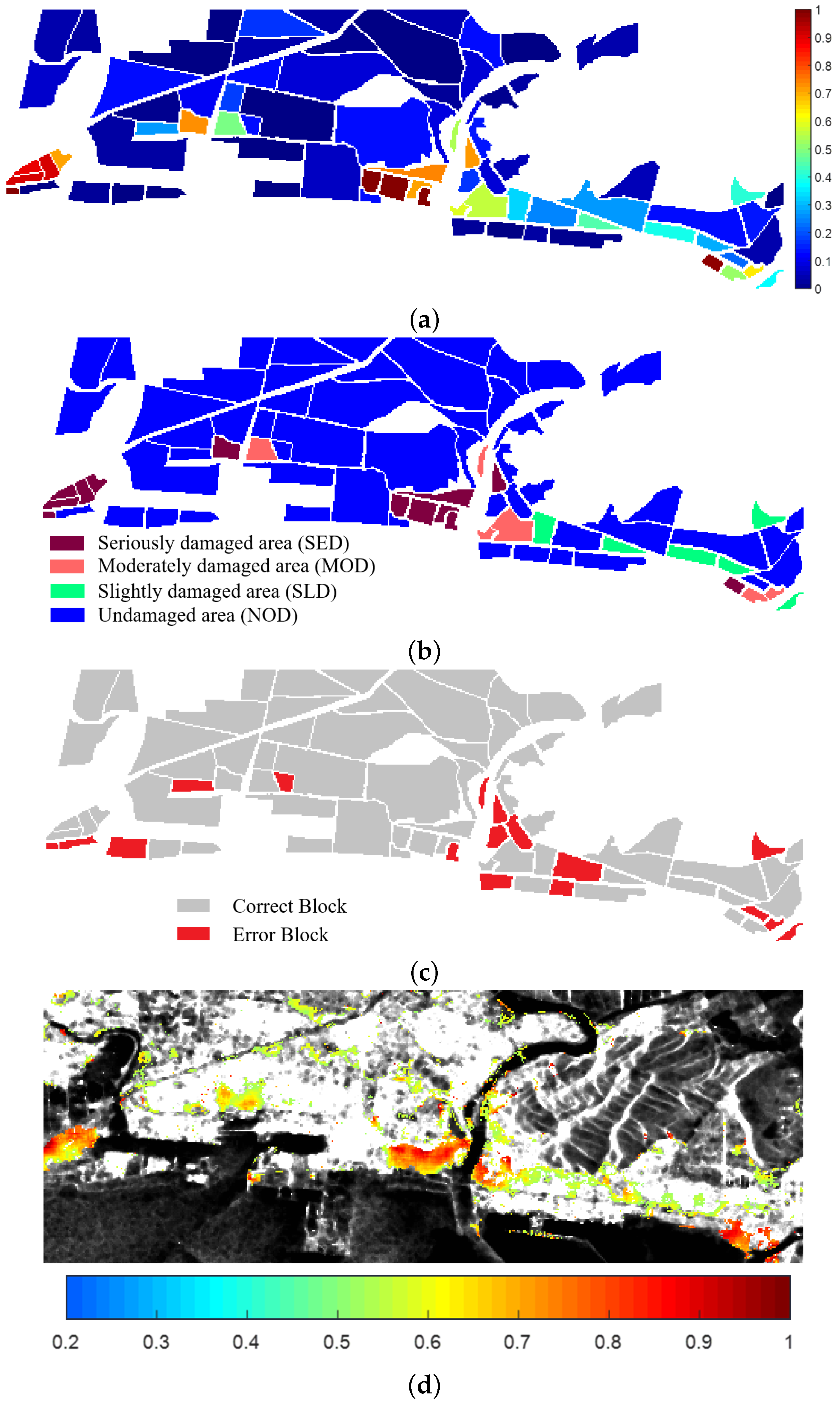


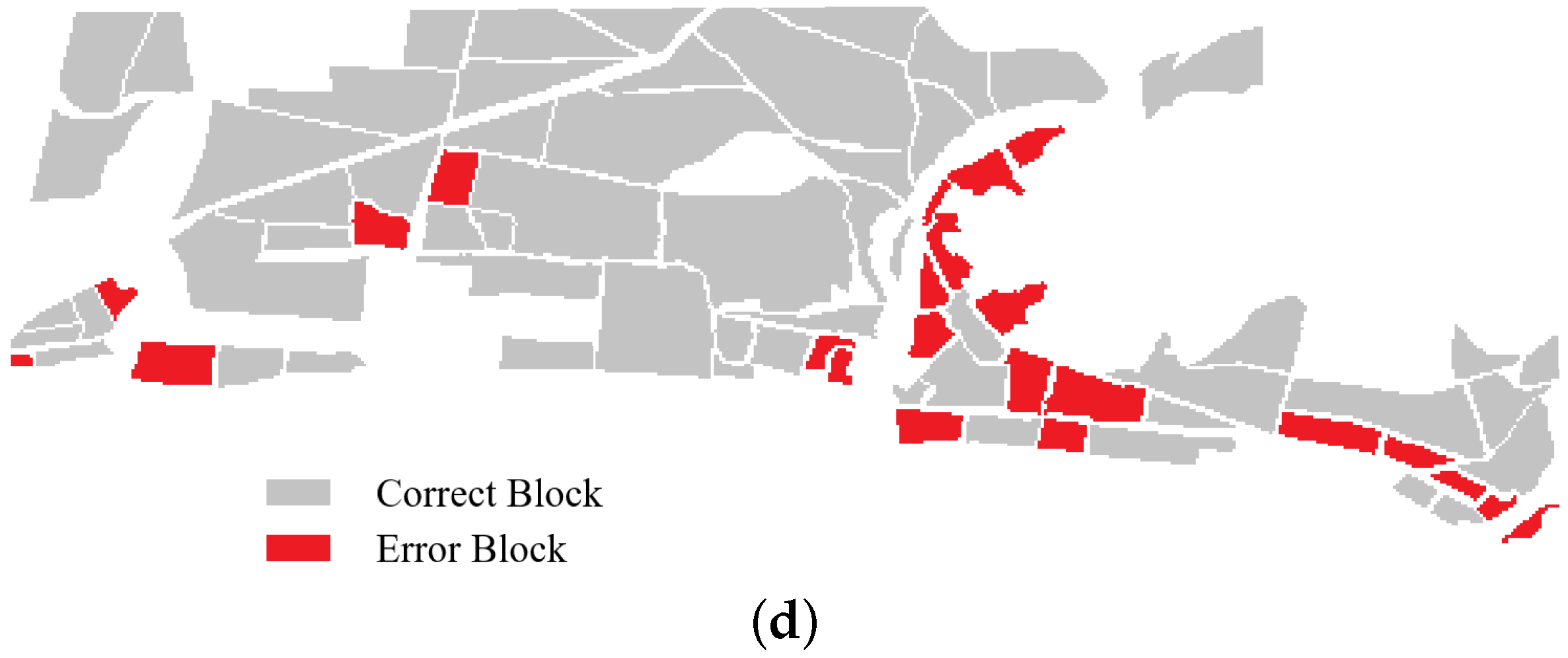
| Supervised SVM | Proposed Method | ||||||||
|---|---|---|---|---|---|---|---|---|---|
| SED | MOD | SLD | NOD | SED | MOD | SLD | NOD | ||
| (Number of Blocks Matched to Ground-Truth Damage Degree) | |||||||||
| SED | 7 | 3 | 0 | 0 | 10 | 0 | 0 | 0 | |
| Damage degree | MOD | 0 | 5 | 0 | 0 | 0 | 4 | 0 | 1 |
| (ground truth) | SLD | 1 | 3 | 4 | 8 | 2 | 1 | 4 | 9 |
| NOD | 1 | 2 | 5 | 41 | 1 | 1 | 2 | 45 | |
| C/T | 7/10 | 5/5 | 4/16 | 41/49 | 10/10 | 4/5 | 4/16 | 45/49 | |
| Accuracy | 73.72% | 100% | 23.05% | 96.6% | 100% | 87.67% | 27.57% | 98.74% | |
| Overall accuracy: 88.81% | Overall accuracy: 92.28% | ||||||||
© 2018 by the authors. Licensee MDPI, Basel, Switzerland. This article is an open access article distributed under the terms and conditions of the Creative Commons Attribution (CC BY) license (http://creativecommons.org/licenses/by/4.0/).
Share and Cite
Ji, Y.; Sri Sumantyo, J.T.; Chua, M.Y.; Waqar, M.M. Earthquake/Tsunami Damage Assessment for Urban Areas Using Post-Event PolSAR Data. Remote Sens. 2018, 10, 1088. https://doi.org/10.3390/rs10071088
Ji Y, Sri Sumantyo JT, Chua MY, Waqar MM. Earthquake/Tsunami Damage Assessment for Urban Areas Using Post-Event PolSAR Data. Remote Sensing. 2018; 10(7):1088. https://doi.org/10.3390/rs10071088
Chicago/Turabian StyleJi, Yaqi, Josaphat Tetuko Sri Sumantyo, Ming Yam Chua, and Mirza Muhammad Waqar. 2018. "Earthquake/Tsunami Damage Assessment for Urban Areas Using Post-Event PolSAR Data" Remote Sensing 10, no. 7: 1088. https://doi.org/10.3390/rs10071088
APA StyleJi, Y., Sri Sumantyo, J. T., Chua, M. Y., & Waqar, M. M. (2018). Earthquake/Tsunami Damage Assessment for Urban Areas Using Post-Event PolSAR Data. Remote Sensing, 10(7), 1088. https://doi.org/10.3390/rs10071088






